This creamy sausage pasta is the perfect weeknight dinner. Savoury sausages, veggies and tender pasta are tossed through a bold and creamy sauce that is packed with flavour. And this ultra-comforting dish can be on the table in just 20 minutes with minimal prep!

Why you will love this recipe
- Quick and easy – the creamy sauce can be prepared in the time that it takes to cook the pasta, making it a quick and easy dinner when you’re short on time.
- Family friendly – adjust the spice level to suit your tastes. It can also be adapted to add whatever veggies you have in the fridge.
- Budget friendly – using sausages, pasta and basic pantry staples, it is a cheap and filling dinner that can be stretched even further with more veggies.
- Reheats well – the whole dish or just the sauce can be made ahead and reheated on busy nights when you need an easy dinner.
- A simple weeknight dinner that you’ll make again and again!
Ingredients you will need
** This post contains tips and instructions to achieve the best possible results. This photo is a great guide for when you are in the supermarket, but for full ingredient quantities and methods, please scroll down to the detailed recipe card below!

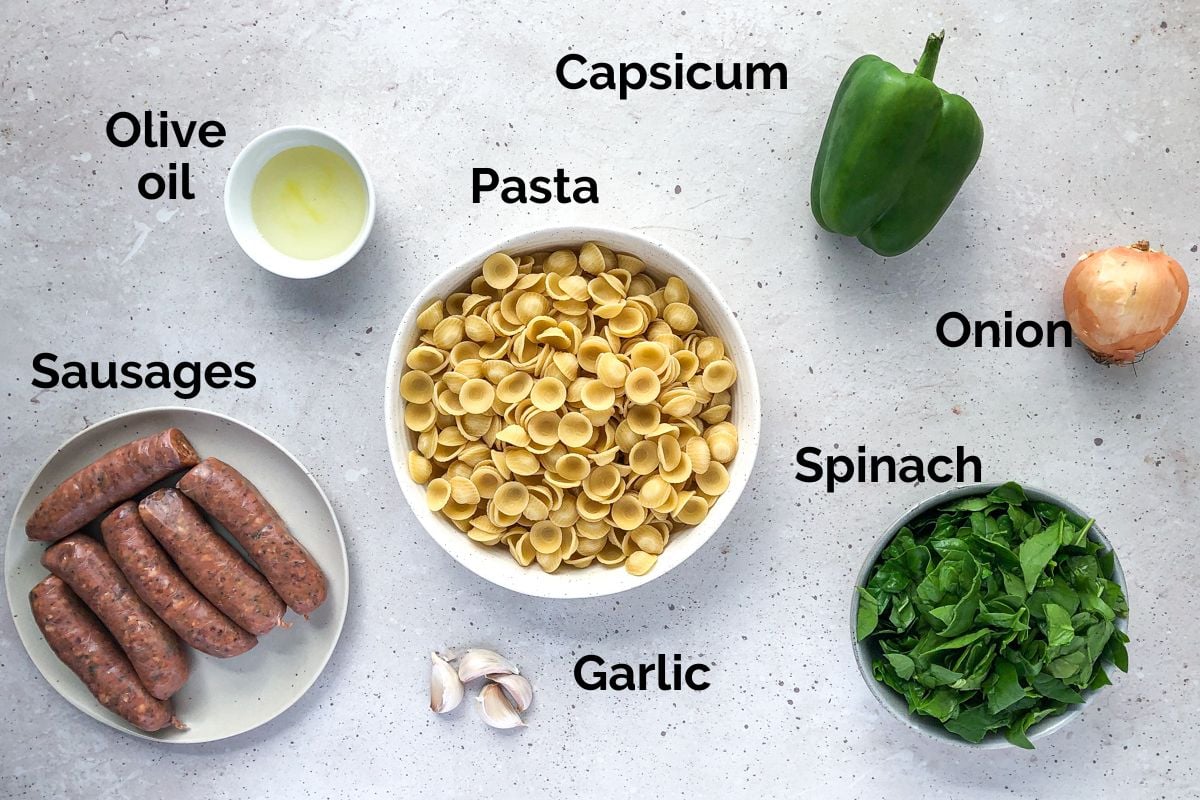
- Sausage – while any kind of sausage will work, I recommend using the best quality sausage you can afford. The type, flavour and quality of sausage used will affect the final flavour and spice level of the sauce, so choose your favourite! Italian sausages, Cajun, pork, beef or chicken sausages can be used.
The sausage is removed from the casing and the sausage meat is either crumbled or rolled into little balls to cook throughout the sauce. *And this recipe also works with leftover sausages, if this is what you have. Simply slice the sausages and stir them through the sauce to heat through. - Pasta – I recommend choosing small, bite-sized pasta rather than long strands, as the creamy sauce will soak into every little corner and groove. Fusilli (spirals), casarecce, bow tie macaroni or penne are all great options. It would also work with gnocchi or ravioli. Gluten-free pasta can also be used.
- Cheese – Pecorino Romano cheese adds bold flavour, as well as helping to thicken the sauce. Grate your own fresh cheese instead of using pre-packaged shredded cheese. Pre-packaged cheese won’t melt into the sauce and will clump together, leaving you with a lumpy sauce that won’t thicken. Pecorino can be substituted for parmesan cheese.
- Cream – use full-fat cooking cream for best results, as it won’t split or separate in the sauce. Regular thickened cream can also be used, but stir it through the sauce with the heat off to prevent splitting.
- Paprika – ground paprika adds a mild sweet and peppery flavour to the sauce. This recipe uses sweet Hungarian paprika, rather than smoked or hot paprika.
- Cayenne pepper – this ingredient is optional and can be decreased or increased to suit your taste. The spice level will also depend on the type and brand of cayenne used, so add a little first and then adjust, to taste.
- Baby spinach – spinach is added through the sauce at the end, to wilt in the residual heat. You can leave it out, or swap for your choice of vegetables.
- Canned tomatoes – passata or finely crushed canned tomatoes from the supermarket can be used.
Step by step instructions
Full ingredient notes and quantities can be found in the detailed recipe card below.
Step 1 – Remove the sausage casing;
Squeeze the sausage meat from the casing into a bowl.

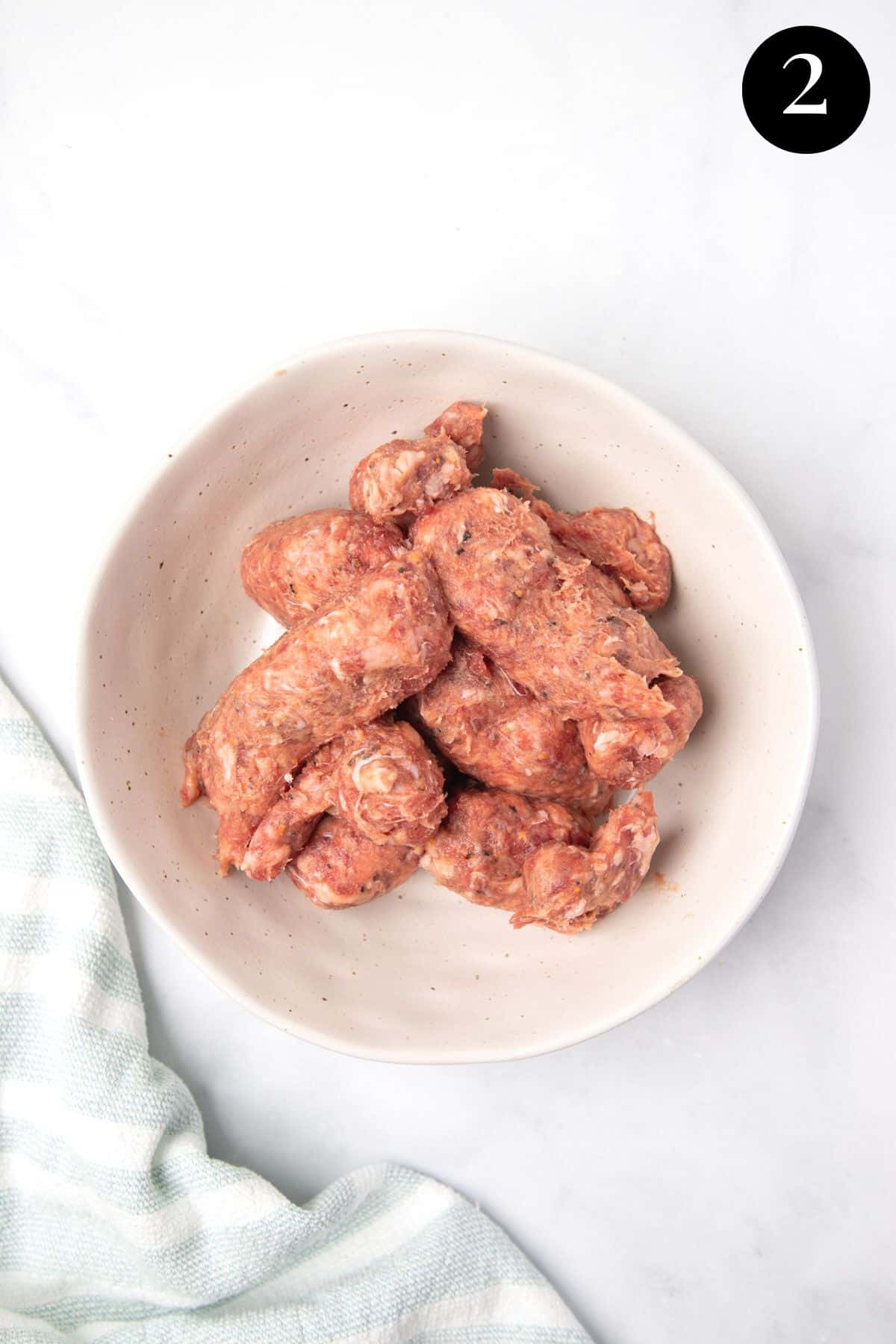
Using your hands, roll the sausage meat into small meatballs. Alternatively, the sausage meat can be roughly crumbled.

Step 2 – Cook the pasta;
Place the pasta into a pot of salted boiling water and cook until al dente.
Step 3 – Make the sauce;
While the pasta is cooking, fry the onion and garlic in a pan with the olive oil, until soft and fragrant.
Add the sausages and gently fry, turning, until browned on all sides. Quickly add the capsicum and stir.

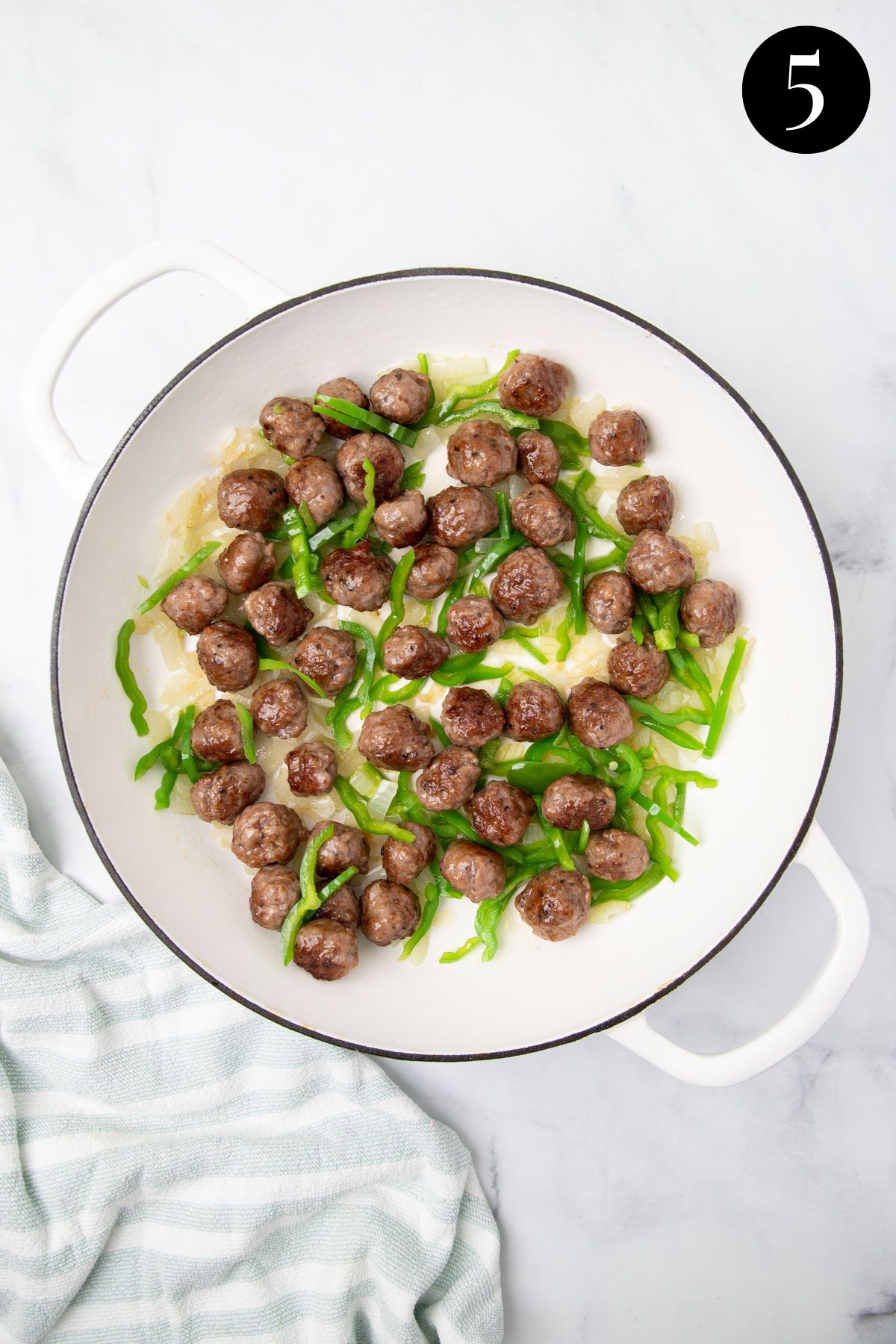
Add the paprika, garlic powder, onion powder, oregano, cayenne and thyme and stir.
Pour in the tomato paste, canned tomatoes and chicken stock and bring to a low simmer. Simmer for 5 minutes.
Turn the heat off and carefully add the cooking cream and pecorino (or parmesan). Stir for one minute, until the cheese has mostly melted throughout the sauce.
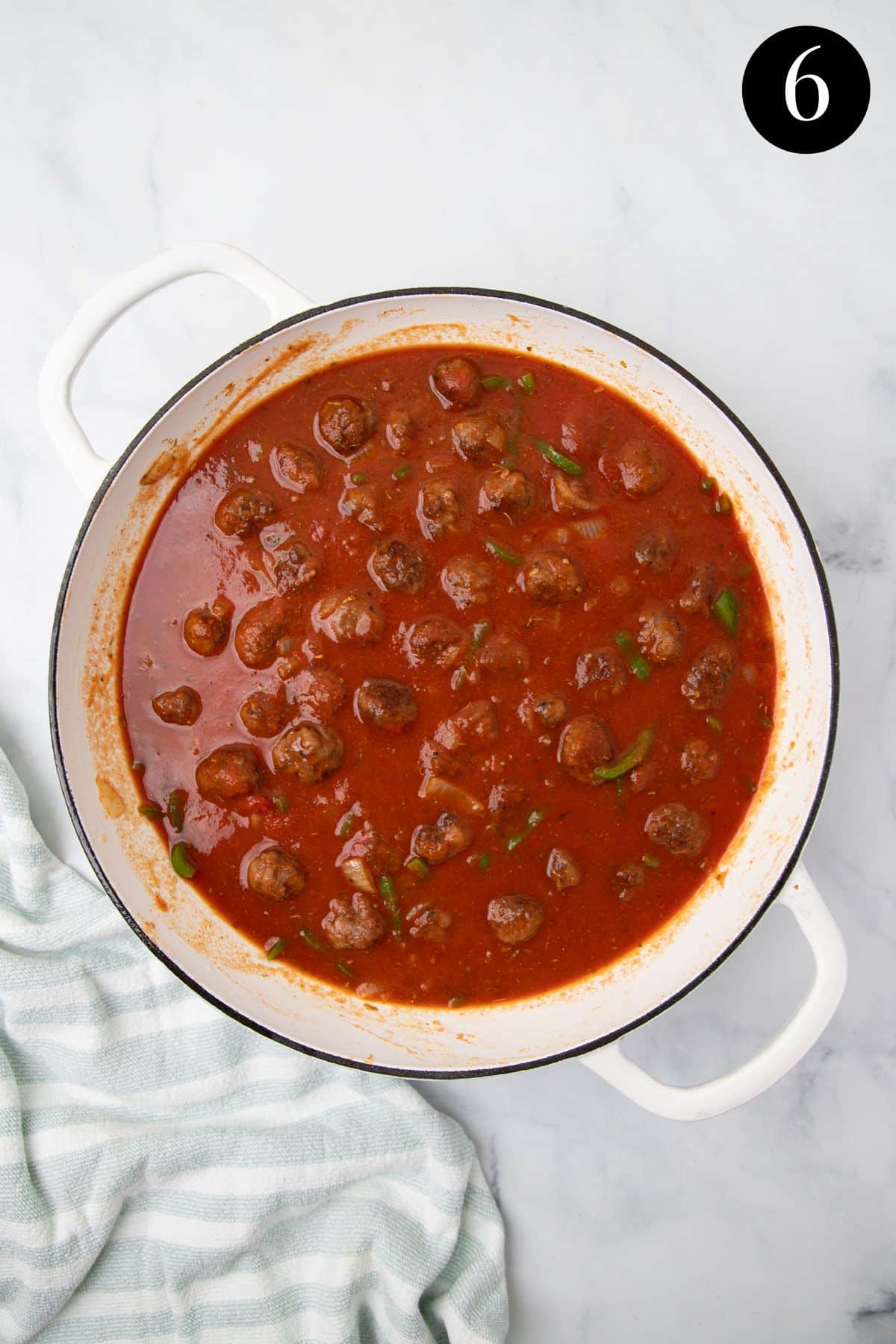
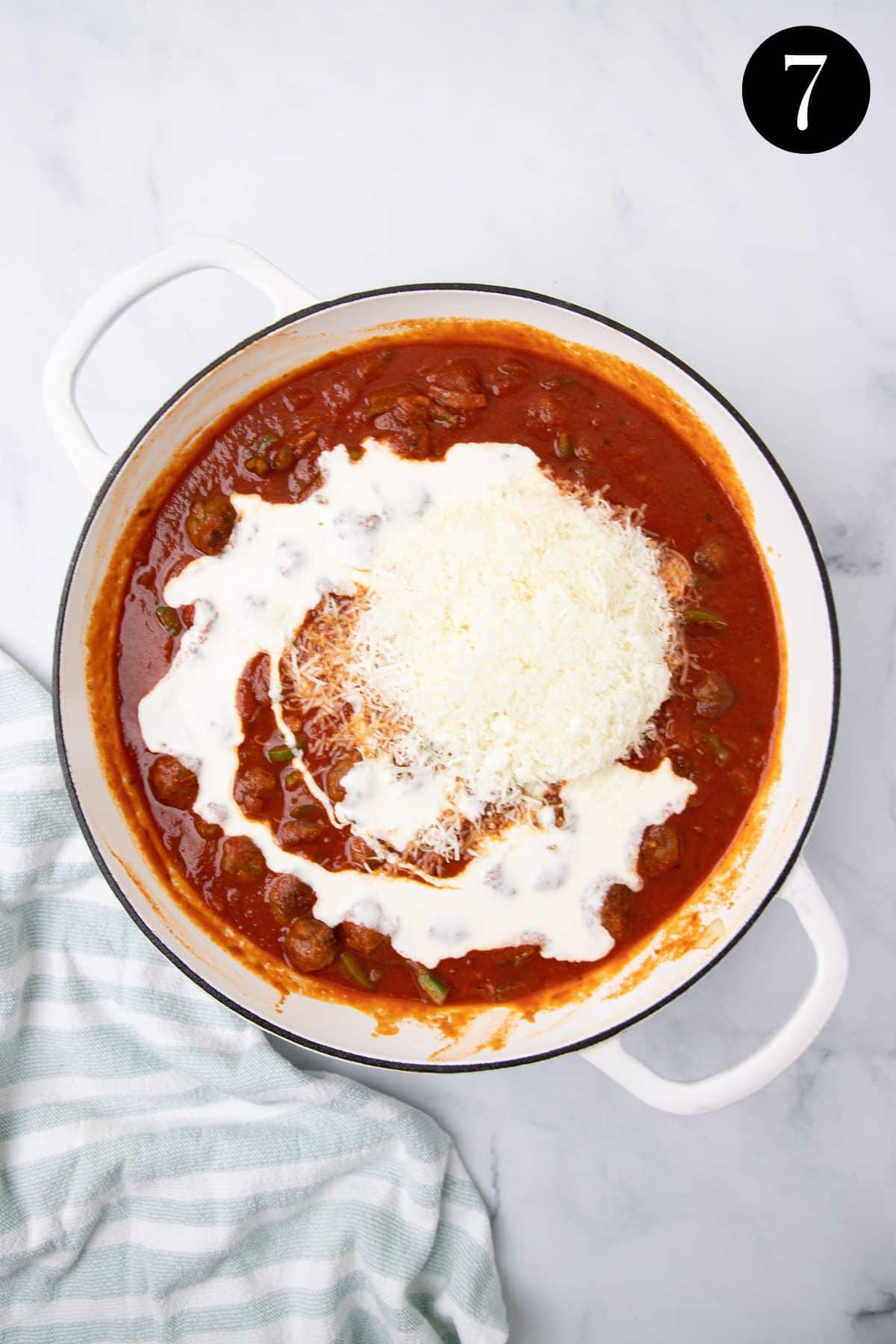
Add the spinach leaves and stir through, until wilted. Add the drained, cooked pasta and stir to combine.
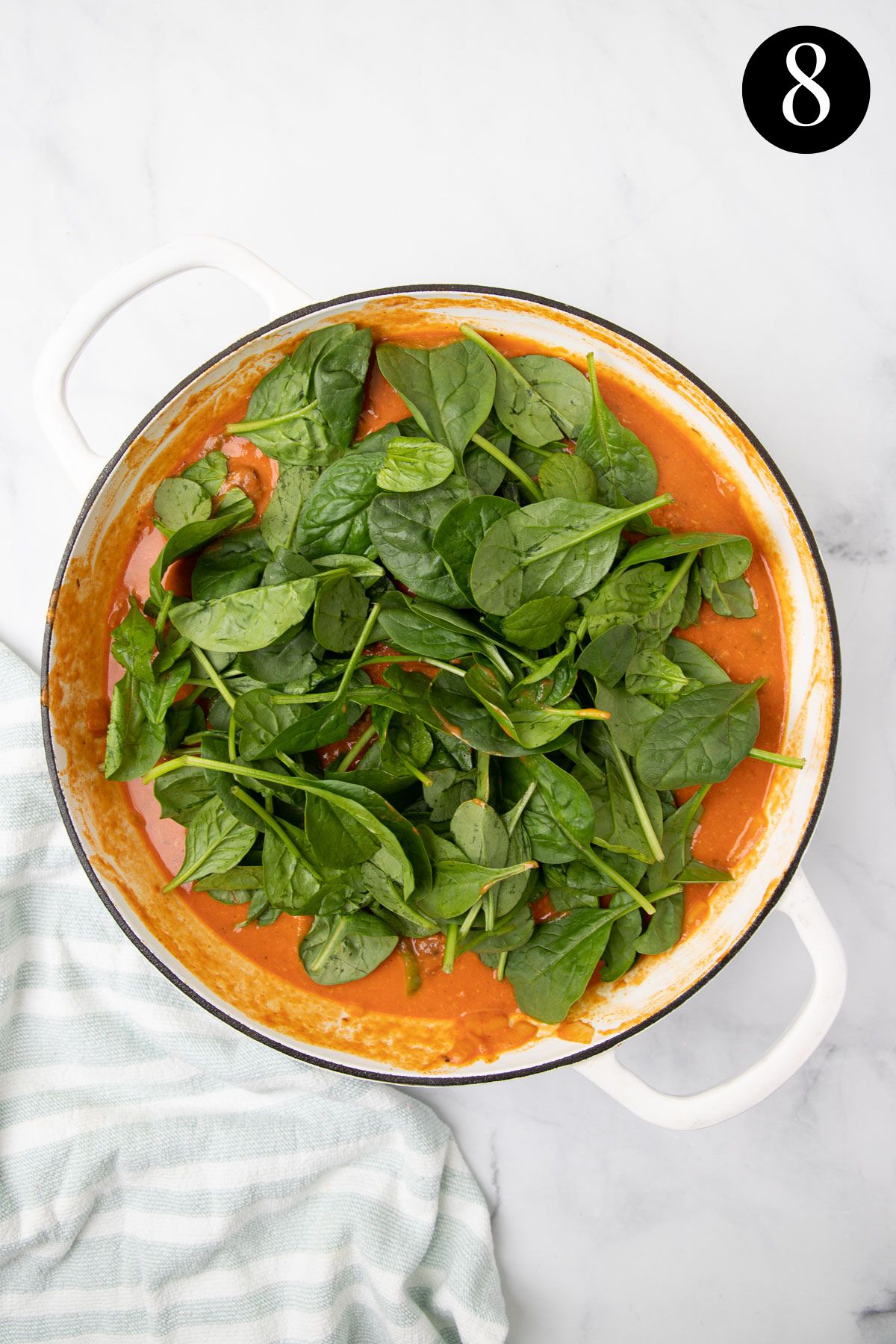

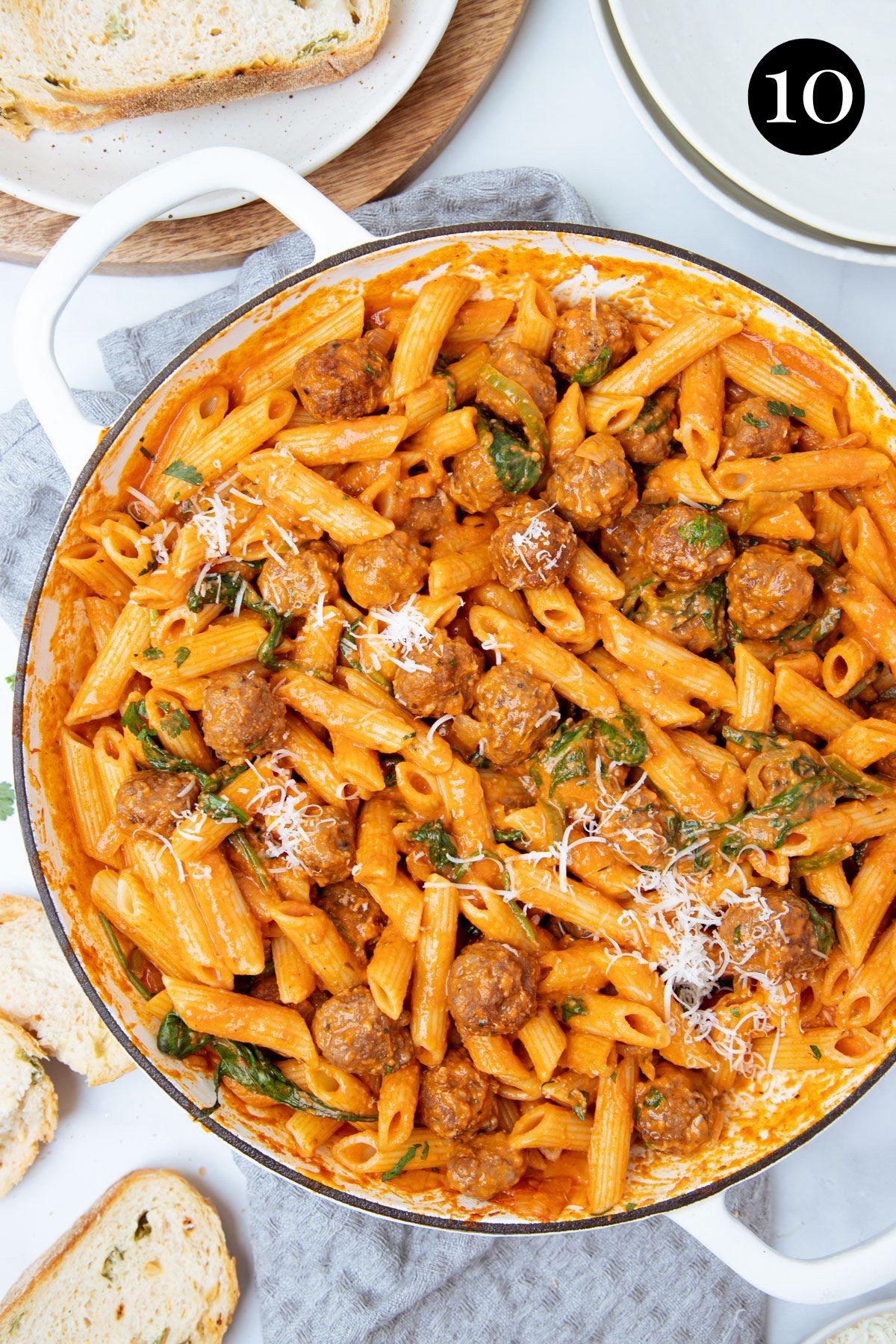
Expert tips
- When adding the cream to the sauce, make sure the heat is turned off completely (or very low), or the cream may overheat and cause the sauce to split. Cooking cream is recommended for this reason.
- Use freshly grated pecorino cheese, rather than pre-packaged shredded cheese. The melted cheese works to thicken the sauce as it sits. However pre-packaged cheese will clump together and won’t fully incorporate into the sauce, leaving it runny.
- This recipe does not contain extra salt. This is because the pasta water is salted and the cheese, sausages and stock all add their own seasoning and flavour to the sauce. Taste and the end and only add more seasoning if needed.
- Leave the sauce to sit for a few minutes after adding the cheese and cream. It will thicken as it sits.
- Removing the sausage casings helps to evenly distribute the sausage meat throughout the sauce and infuse the flavours throughout the dish.
- Leftover sausages can be used instead of using sausage meat removed from the casing. Slice the sausages and add them to the sauce at the end, until heated through.
- Variations – try adding a handful of chopped sun-dried tomatoes to the finished sauce along with the spinach. Or add some grated zucchini, grated carrot, peas or corn when you add the capsicum for extra veggie content. This is a great recipe for a fridge clean out.
FAQs
Sausage pasta tastes even better the next day, once the flavours have had time to develop. Keep leftovers tightly covered in the fridge for up to 4 days and reheat until steaming hot when you are ready to eat it.
Sausage pasta can be reheated on the stovetop or in the microwave. To reheat on the stovetop, add a splash of stock, a little reserved pasta water and/or a little more cheese to loosen the sauce. Stir over medium heat in a large pan until steaming hot. To reheat in the microwave, cook individual serves on ‘auto reheat’ or medium-high power for 1-3 minutes (stirring 2-3 times in between), or until steaming hot.
The entire pasta dish (or just the sauce) can be made ahead and frozen, to enjoy later. For best results, I recommend freezing the sauce on its own and adding fresh pasta when you are ready to eat it. This is because pasta can go a little mushy in the freezer and always tastes better fresh.
Allow the sausage pasta (or cooked sauce without the added pasta) to cool completely and place into a freezer-safe container. Freeze for up to 2 months. Thaw overnight in the fridge and reheat on the stovetop or in the microwave until steaming hot. It may need a splash of stock to loosen the sauce.
Any sausages will work. But I recommend choosing the best quality sausages you can afford, as the type, flavour and quality of sausage will affect the final flavour and spice level. Italian, Cajun, pork, beef or chicken sausages can be used. Andouille sausages or chorizo can also be used, but they need to be finely sliced or crumbled rather than removed from their casing. Choose a good quality sausage with bold flavours and your desired level of heat for best results.
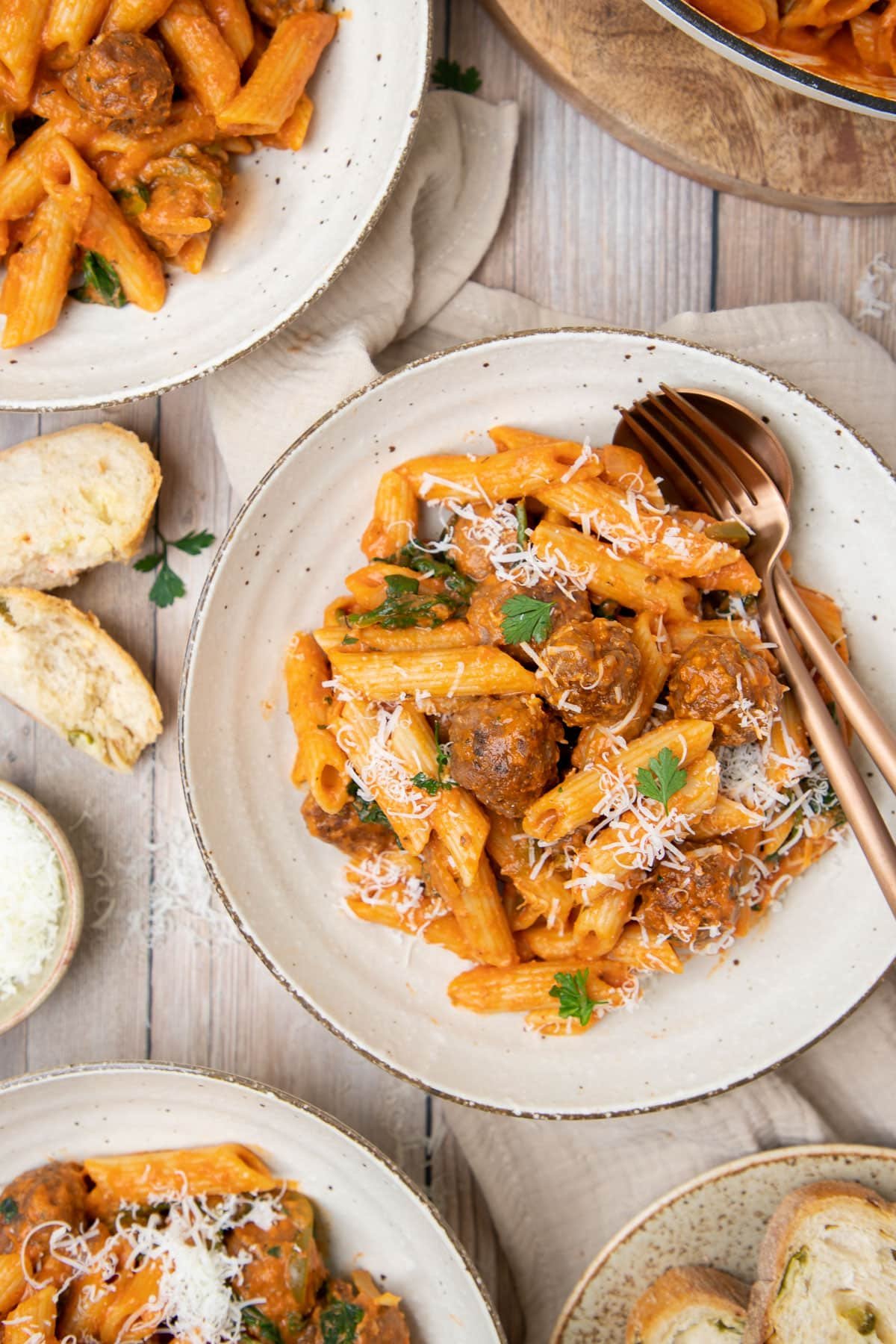
Related recipes
Tried this recipe? Please leave a star ⭐⭐⭐⭐⭐ rating or leave a review below and let me know how you went!
Hungry for more? Subscribe to my newsletter and follow along on Facebook, Instagram and Pinterest for the latest recipes and news.

Creamy Sausage Pasta
Ingredients
- 500 grams sausages approx. 6 sausages. Use beef, pork or chicken, or swap for crumbled chorizo or Andouille sausage.
- 400 grams dried pasta Choose your favourite type of pasta.
- 1 brown onion diced
- 4 cloves garlic peeled and crushed
- 2 tablespoons olive oil
- 1 green capsicum finely sliced
- 2 teaspoons sweet paprika sweet Hungarian paprika, not hot or smoky paprika
- 1 teaspoon garlic powder
- 1 teaspoon onion powder
- 1 teaspoon dried oregano
- ½-1 teaspoon cayenne powder adjust to suit your personal taste, or omit.
- ½ teaspoon dried thyme leaves
- 2 tablespoons tomato paste
- 1 ½ cups canned, crushed tomatoes or passata
- 1 cup liquid chicken stock
- ½ cup cooking cream or heavy cream
- 1 cup pecorino romano cheese fresh, finely grated. Can be swapped for parmesan
- 3 cups baby spinach leaves
To serve
- extra pecorino cheese freshly grated. (or parmesan).
Instructions
- Over a bowl, gently squeeze the sausage meat from the sausage casing. Discard the sausage casings.
- Use your hands to roll the sausage meat into small meatballs. Alternatively, the sausage meat can be roughly crumbled into small pieces.
- Place the pasta into a pot of boiling, salted water and cook according to the packet instructions, until al dente.
- While the pasta is cooking, heat a large frying pan over low heat. Cook the onion, garlic and olive oil for 1-2 minutes, stirring, until soft and fragrant.
- Increase the heat to medium-high and add the sausage meatballs. Cook for 2-3 minutes, turning, until they are browned on all sides. Add the capsicum and stir.
- Add the paprika, garlic powder, onion powder, oregano, cayenne and thyme and stir.
- Add the tomato paste, canned tomatoes and stock and stir to combine. Bring to a low simmer and simmer for 5 minutes.
- Turn the heat off. Carefully add the cooking cream and grated cheese and stir for 1-2 minutes, until the cheese has mostly melted.
- Add the spinach leaves, stirring until the leaves have wilted.
- When the pasta is al dente, drain it and add it to the pasta sauce. Stir to combine and allow everything to sit in the pan for 1-2 minutes while the sauce continues to thicken.
- Top with some more freshly grated pecorino cheese and serve while hot.
Notes
- When adding the cream to the sauce, make sure the heat is low or turned off completely and don’t simmer it for too long, or the cream may overheat and cause the sauce to split.
- Use freshly grated pecorino cheese, rather than pre-packaged shredded cheese. The melted cheese works to thicken the sauce as it sits. However pre-packaged cheese will clump together and won’t fully incorporate into the sauce, leaving it runny.
- This recipe does not contain extra salt. This is because the pasta water is salted and the cheese, sausages and stock all add their own seasoning and flavour to the sauce. Taste and the end and only add more seasoning if needed.
- Leave the sauce to sit for a few minutes after adding the cheese and cream. It will thicken as it sits.
- Removing the sausage casings helps to evenly distribute the sausage meat throughout the sauce and infuse the flavours throughout the dish.
- Leftover sausages can be used instead of using sausage meat removed from the casing. Slice the sausages and add them to the sauce at the end, until heated through.
- Variations – try adding a handful of chopped sun-dried tomatoes to the finished sauce along with the spinach. Or add some grated zucchini, grated carrot, peas or corn when you add the capsicum for extra veggie content. This is a great recipe for a fridge clean out.
- Storage; Sausage pasta tastes even better the next day, once the flavours have had time to develop. Keep leftovers tightly covered in the fridge for up to 4 days and reheat until steaming hot when you are ready to eat it.
- Reheating; Sausage pasta can be reheated on the stovetop or in the microwave. To reheat on the stovetop, add a splash of stock and/or a little more cheese to loosen the sauce. Stir over medium heat until steaming hot. To reheat in the microwave, cook individual serves on ‘auto reheat’ or medium-high power for 1-3 minutes (stirring 2-3 times in between), or until steaming hot.
- Freezing; The entire pasta dish (or just the sauce) can be made ahead and frozen, to enjoy later. For best results, I recommend freezing the sauce on its own and adding fresh pasta when you are ready to eat it. This is because pasta can go a little mushy in the freezer and always tastes better fresh. Allow the sausage pasta (or cooked sauce without the added pasta) to cool completely and place into a freezer-safe container. Freeze for up to 2 months. Thaw overnight in the fridge and reheat on the stovetop or in the microwave until steaming hot. It may need a splash of stock to loosen the sauce.
- Please note that the nutrition information is based on the pasta being divided into 6 bowls, with one bowl being one serve. The nutritional information is an estimate only and does not take into account any additional toppings or sides served with the pasta.
- This recipe is made using Australian cups and spoon measurements. Any reference to cups or spoons in this recipe is in Australian metric. Due to cup sizes varying from country to country, I advise adjusting if necessary.
Nutrition
Are you following us on Facebook, Instagram and Pinterest?
Update Notes: This recipe was originally published in December 2020 but was re-published with new information, helpful tips and photos in February 2023.




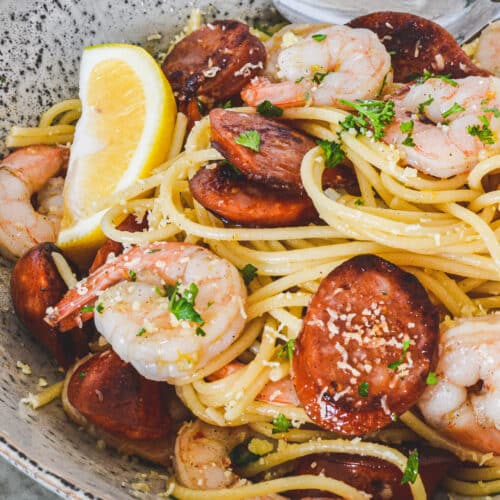
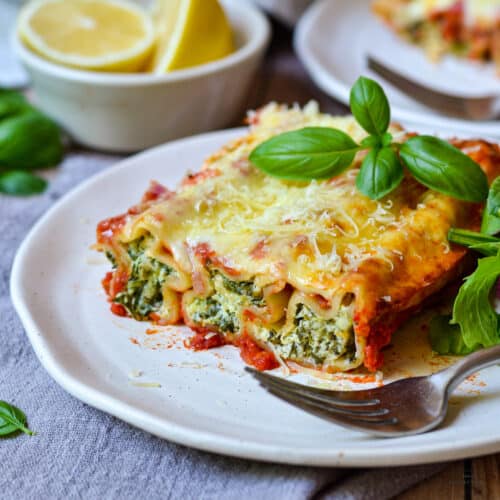




Leave a Reply